When you find scale on your plants, getting rid of them can take some time – but it’s not impossible. I’ve successfully descaled my houseplants, and so can you.
In this post, you’ll learn how to identify them, where they come from, and the best natural and organic methods to get rid of them – FOR GOOD.
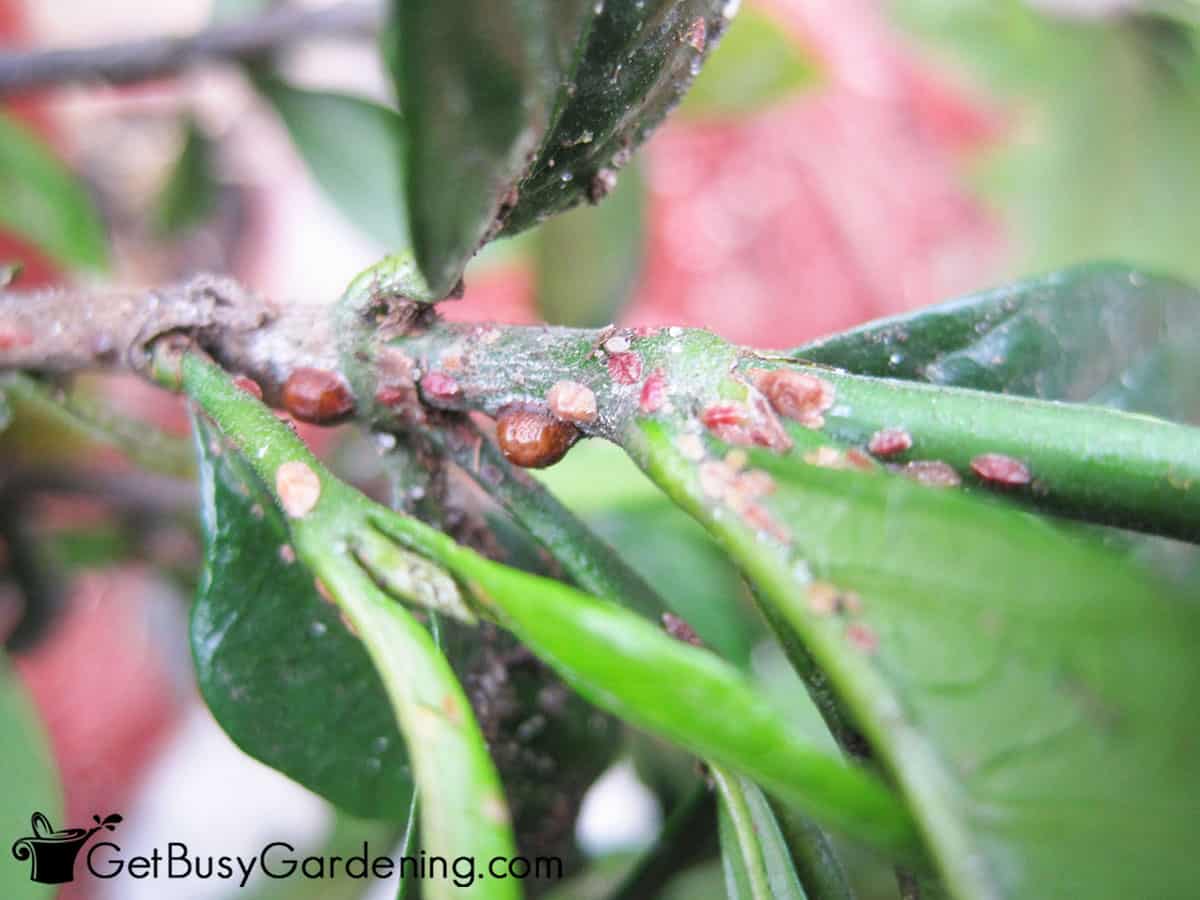
What Are Scale Insects?
Houseplant scale insects suck the sap out of the leaves and stems. This results in stunted or deformed leaf growth, yellowing of the leaves, brown pock marks, and possibly leaf drop.
You can find them almost anywhere on a plant, but they’ll usually be hanging out on the stems and leaf joints, and along the veins of the leaves.
You may also notice sticky leaves on the leaves, on the pot, or around the area where the plant is sitting.
This sticky substance is usually the best way to help with identification if you’re unsure. That’s because as the insects feed, they excrete a sticky residue, which is a common sign of an infestation.
What Do They Look Like?
Scale insects can be very difficult to see. Even if you do notice them, they appear more like a weird growth rather than a bug.
In fact, they look like small brown dots or bumps, and they don’t move. Eek! To me, they look like scabs on a plant (and that’s seriously what I thought they were the first time I saw them, haha).
They can be rounded, oval shaped, or flat, and can range in size from barely visible to large bumps. Their color can range anywhere from brown to tan to white.
Scale likes to cluster, so they are very noticeable once the population gets large. Like I said before, they don’t look like bugs so you probably won’t even notice them until your plant has become infested.
If the bugs on your houseplants are white and fuzzy and look more like mildew, those are mealybugs, and here’s how to get rid of them.
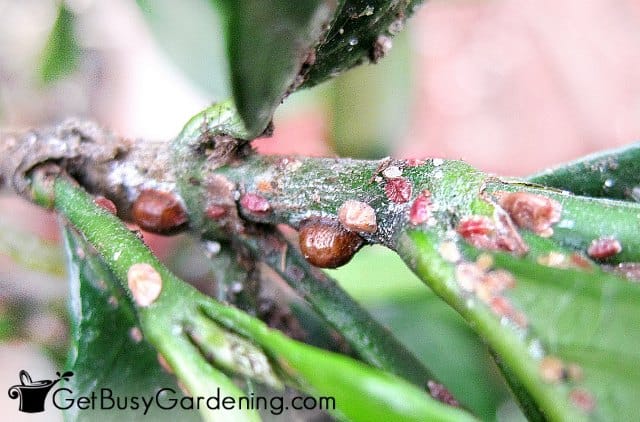
Their Life Cycle
Scale can reproduce very quickly. Their entire cycle takes about 7-10 weeks, and it has several stages.
It takes a few weeks for the eggs to hatch into nymphs (aka crawlers), and then another 6-9 weeks for the crawlers to mature into adults.
The nymphs can move around on a plant or migrate to surrounding ones. Once they find a good place to start feeding, and they mature into adults, they never move again.
The eggs and nymphs are tiny, so it’s easy to understand why most people will never know their houseplant has scale until the population has exploded.
Scale Damage On Plants
Scale insect damage can look like pock marks on plants like succulents and cacti, or it can be something as subtle as brown or yellow leaves.
Thankfully, the damage they cause is not as quick to occur or as devastating as it is with spider mites, but it can still look pretty bad.
If an infestation is left untreated, the plant could eventually die. Although it would take a long time, and a very large population for them to kill a mature indoor plant.
Related Post: How to Get Rid of Fungus Gnats In Houseplants Soil
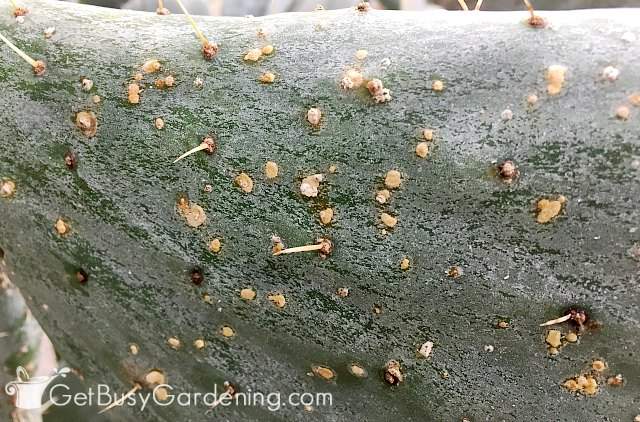
Where Do Scale Bugs Come From?
When you discover scale on your indoor plant, the first question you’ll ask is where the heck did they come from? They’re actually very sneaky, and many times you will never figure out where they came from.
They can come from just about anywhere, so it’s easy to go crazy trying to figure it out. Here are 6 of the most common sources:
- Bringing home a new houseplant from the store
- Using contaminated potting soil
- Reusing a dirty plant pot
- Moving your indoor plants outside during the summer
- Bringing in fresh produce or cut flowers from the garden (or even from the grocery store)
- Leaving a window open – the crawlers are tiny, so they can get through the smallest openings
Read more about all of the places where houseplant bugs can come from here.
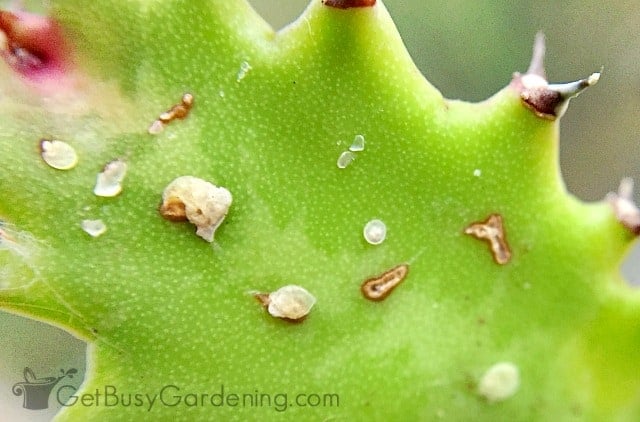
How To Get Rid Of Scale Insects On Houseplants
When you first find scale insects, you should isolate the infested plant and begin treatment immediately.
I don’t recommend using synthetic chemical pesticides. That’s because scale can build up a resistance to them, especially ones they are exposed to on a regular basis. Plus, in most stages of their life cycle, pesticides won’t penetrate their hard outer shell anyway.
Always use natural, organic methods instead. They are not only better for us and our family, they work to kill the bugs, and they can’t build up resistance to them.
You can learn even more about all-natural houseplant pest control remedies here.
Natural Treatment Methods
To help get you started, I’m sharing three of the best natural treatment methods. But before you begin, here are a few of my favorite tips:
- As you work on treating your plants you should check every crevice, especially around the leaf and stem joints and underneath all of the leaves.
- They like to hide, so be sure to check the plant from a bunch of different angles.
- Brush away a little dirt around the base of the stem to see if any are hiding there. It’s not uncommon to find them on the roots.
Rubbing Alcohol
You can use a cotton swab dipped in rubbing alcohol to kill and remove as many of the scale insects as possible. For the rubbing alcohol to be effective, it must come in direct contact with the bugs.
Some of the adults with the hardest outer shells might be stuck on there good. So you may need to pry some of them off with your fingernail.
This method works very well for small infestations. It also helps to eliminate as many of the large insects as you can so that you can gain the upper hand.

Homemade Insecticide Soap
You could buy organic insecticidal soap, or you can make your own homemade spray. My recipe is 1 teaspoon of mild liquid soap per 1 liter of water.
Either way, spray it directly on the bugs and on the leaves. If your plant is small, you can bring it to the sink or shower and wash the leaves, gently removing as many of the bugs as you can.
Keep in mind that some soaps can be damaging, so it’s best to test any type of spray on a couple leaves before you spray the entire plant.
Neem Oil
Neem oil is a natural insecticide, and it’s very effective for treating scale. An added bonus is that it has a residual effect to help with future prevention too.
It works best when you douse your plant, and continue using it until all signs of the bugs are gone. Learn more about neem oil and how to use it here.
More Tips For Getting Rid Of Scale On Plants
You can’t treat a plant once and expect to get rid of all of the scale, you need to be persistent. Keep checking on them a few times a week, and remove any new bugs that you see. Here are a few additional tips.
1. Replace the top layer of soil – Bugs can hide in the soil, so if a plant is plagued by recurring infestations, you could try removing the top inch and replacing it with fresh potting soil.
2. Clean surrounding area – Crawlers can leave the plant and then come back to infest it again later. So remove it from the area and clean any crevices where the pests could be hiding. Be sure to check around the outside lip and inside edges of the pot and drip tray, and the bottom of the pot for hiding insects.
3. Prune heavily infested leaves – Trim off the most heavily infested leaves and toss them into the trash (outside of your home). Never trim all the leaves off though.
4. Sanitize the pot – If you decide to repot a plant after treating it, be sure to sterilize the container before reusing it. Insects can hide on the edges, bottom, or the rim and easily infest the next plant. Scrub the pot with soapy water, or better yet, put it in the dishwasher to sterilize it.
5. Continue treating your plant – Use a neem oil regularly as a preventative measure until you are sure your plant is scale-free.
Getting rid of scale on your indoor plants can be challenging, but don’t give up! If you’re diligent, and follow my instructions and tips above, you will win the fight!
If you’re struggling with bugs on your indoor plants, my Houseplant Pest Control eBook is for you! It will show you exactly how to get rid of bugs naturally, including identification, home remedies, how to keep them from EVER coming back, and much more. Download your copy today!
More About Houseplant Pests
- How To Debug Plants Before Bringing Them Indoors
- How To Get Rid Of Whiteflies On Indoor Plants
- How To Get Rid Of Bugs On Houseplants
- How To Get Rid Of Aphids On Houseplants
- How To Get Rid Of Thrips On Houseplants
How do you get rid of scale on houseplants? Share your tips in the comments below.
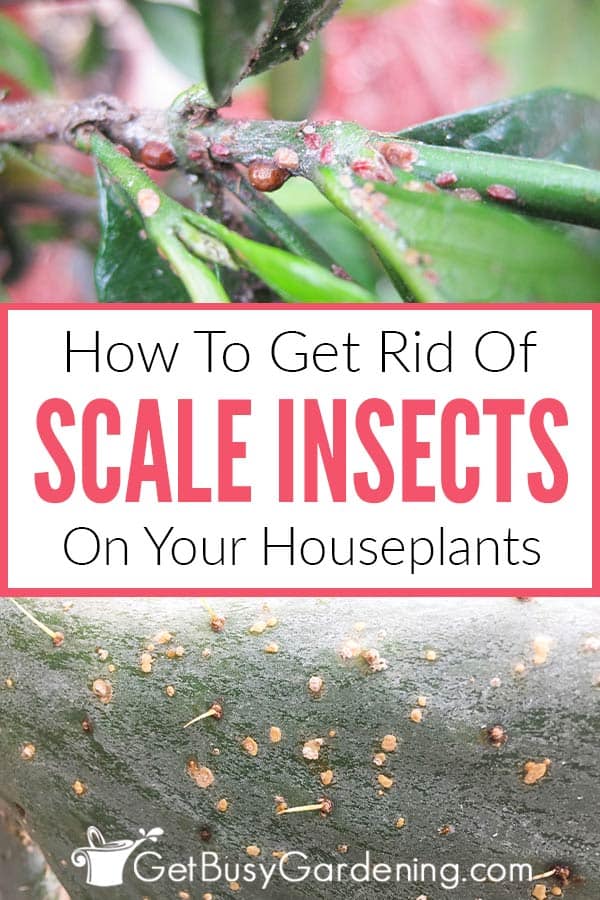
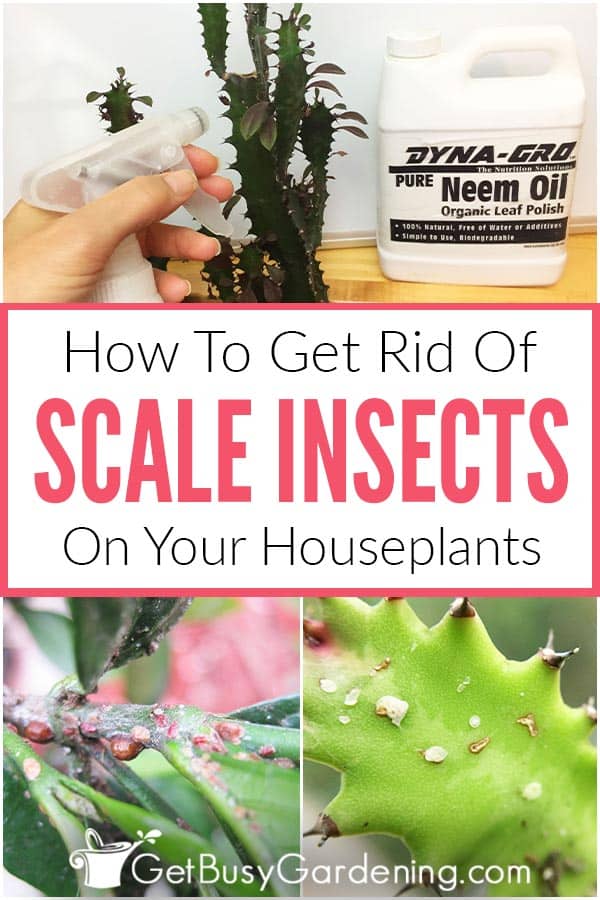

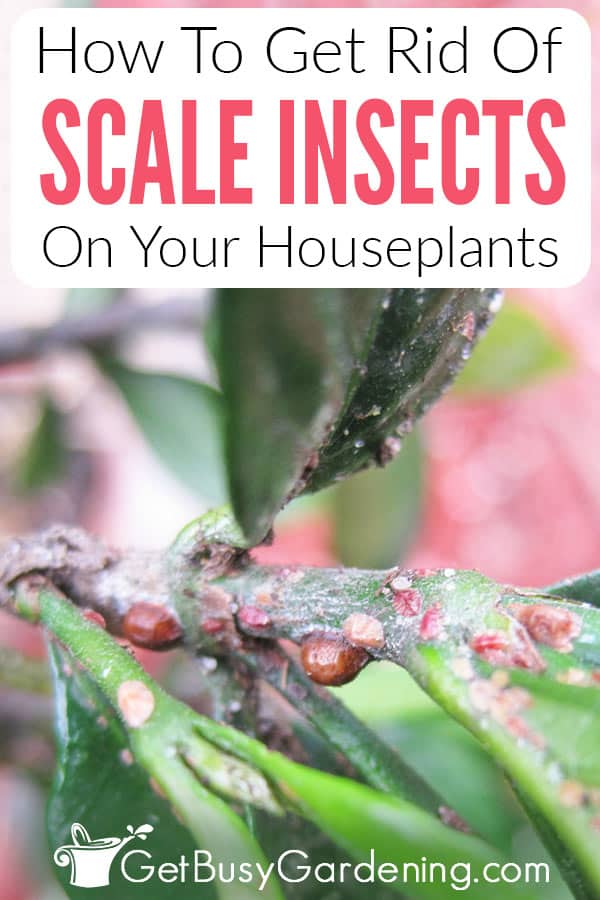
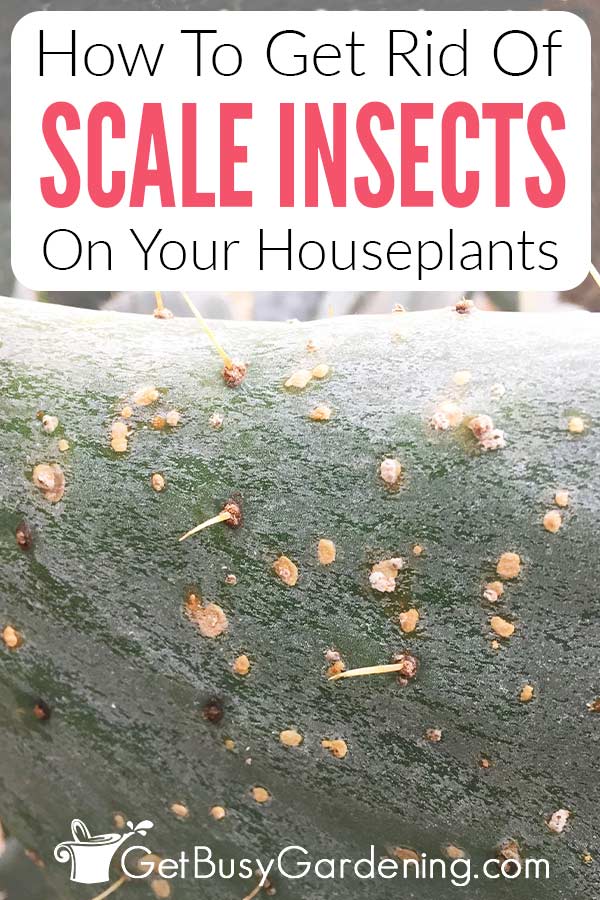
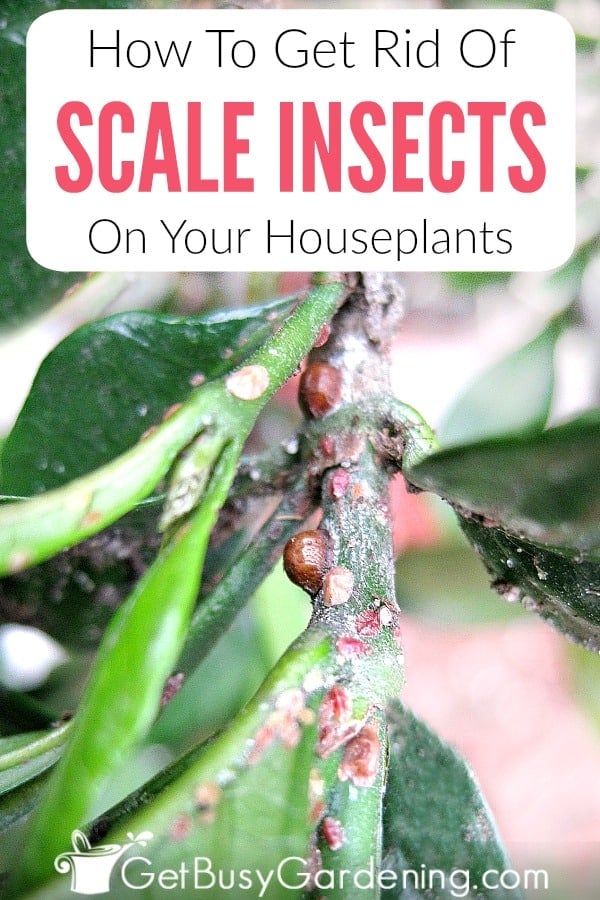

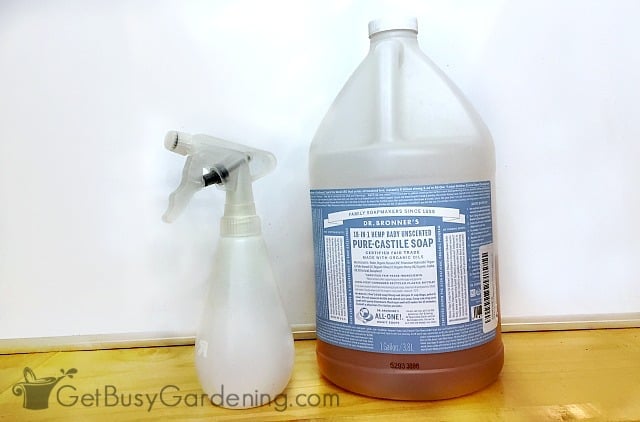
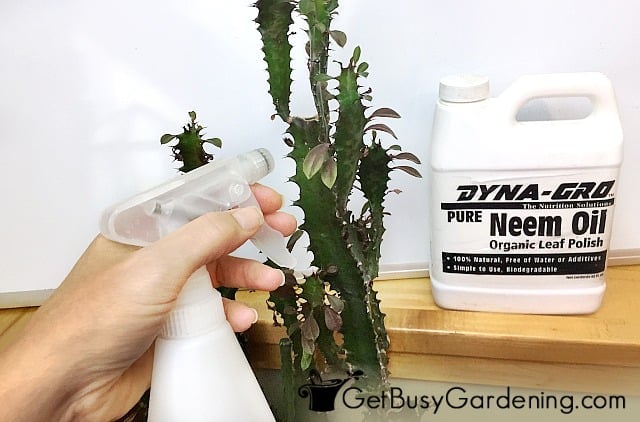
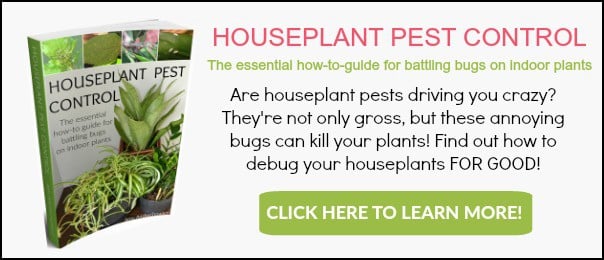

Helen says
I have scale investation on some of the plants in my room, it’s all over the wall, windows and the wood of my dresser. I did not know what they were before so I just scraped it off once and thought it might be from the vent but it came back. How can I get rid of them and make sure they never come back. Please help.
Amy Andrychowicz says
Wow, I’ve never heard of houseplant scale getting on the walls and woodwork like that! Yuck! Rubbing alcohol, soapy water, or really any kind of disinfectant cleaning spray that’s safe to use on those surfaces will kill them. I would scrub down everything to remove and kill them, then keep cleaning the area regularly until you never see scale again. If you have plants in the room, then that is likely where they’re coming from, so make sure you treat the scale on your plants using the methods above, or they will just keep coming back.
Joyce A Solomon says
I have a ficus that is about four feet tall. I have tried neem oil and horticulture oil but it doesn t seem to do anything to get rid of them. also they seem to only be on the side of the tree that is not directly facing the sun. any suggestions the tree is large.
Amy Andrychowicz says
Yes, scale can be difficult to get rid of. You have to be persistent, because you can’t kill them all with only a few treatments. It can take several months (or even over a year) to eradicate a heavy infestation on a large plant. So plan to keep treating it with neem regularly for the long term, even after all signs of the bugs are gone.
Angie says
Hi, you said that also the roots could be infected, in that case what is to be done, wash the roots and repot ?
Amy Andrychowicz says
If scale insects are on the roots, it would be at the top right under the soil, near the stem of the plant. Just brush away the soil right around the base of the plant to see if you find anything there. Definitely don’t repot your plant if it’s infested with scale though. That could further stress the plant, and won’t do anything to get rid of the bugs.
Diana West says
I’m so happy I found your website! There’s a wealth of information here that I’ve never seen before! I will definitely acquire your eBook. I have 1 quick and important question about removing a type of brown soft scale on the base of succulents. I used tweezers and/or a butter knife sharp. It will continue to grow upwards on the stems (or trunk on lg. Plants). Is this process harmful if will weaken the plant? Please advise.
Amy Andrychowicz says
Awesome, glad you like the website and the eBook! Yes, scale will harm the plant over time if left untreated. Though it’s good to scrape them off as part of your treatment routine, the eggs and babies are difficult to see. So, it’s best to use some other type of treatment (neem oil works wonders) to get rid of scale all together. Otherwise, you’ll just be picking off the adults, and you’ll never eradicate the infestation.
Belle says
Thanks for sharing the article on scale (on houseplants). I found it very informative and like that you had pictures of scale and damge due to scale on different types of plants.
Amy Andrychowicz says
You’re welcome, glad you found it informative and helpful! 🙂
alemar says
Hi Amy, we had to throw away a few of our plants because of the scales. Before I saw this post. Can you spray the plants as a preventative measure and if so, how often would you recommend? Also, is the neem oil good for food plants? Thanks!
Amy Andrychowicz says
Oh no, sorry to hear that you lost your plant to scale! Yes, neem oil works great as a preventive spray. I only use it on plants that have had pest issues in the past. You can spray it on every 2-4 weeks. But be sure to read the label on the type of neem oil you get to make sure there aren’t any special instructions.
Laurie Ezrow says
Hi Amy,
I have been dealing with scale for a couple of years. Just when I have it under control on one plant, I find it on another. I just found some on my African Violet. It is a huge specimen with dense foliage, so it is hard to be sure I have removed all of the leaves and stems with scale. Since you cannot get African Violet leaves wet, I was wondering if there is a systemic treatment that I could put in the soil when I water. Mark above mentioned a “soil dunk’ . Not really sure what that is, but I hesitate to use anything harmful to the plant in the soil. I have had this plant for 20 years or so and I would hate to loose it.
Thank you for the information.
Amy Andrychowicz says
Ugh, I’m so sorry to hear about your persistent problems with scale. The first thing I would do is move all of the plants that don’t have scale as far away from the area as possible (and keep a close watch on the to be sure no scales appear!). Maybe even to a different room if you can. Scale insects can hide in crevices away from the plant for some time, and then, just when you think you get rid of them, they come out of hiding and re-infest the plants! Then I would move the infested plant to a different area and completely isolate it as you work to get rid of the scale insects. Be sure to clean the area where the plant was really well, and get into every crevice you can. Also, clean the pot and plant tray really well too, being sure to get under the lip and the bottoms too.
As for treating your African violet, I would continue to work on hand picking the ones that you can find every day. I have heard that neem oil works as a systemic pesticide, but have never tried it myself, and have never used it for African violets. I believe what Mark was talking about is to pour the neem oil concentrate into the soil until it comes out of the bottom drainage holes to really saturate the soil with it (be careful not to overwater your plant though).
You could also try pouring the neem solution onto a cloth to dampen it, and gently rubbing it over one leaf. Leave it for a few days, and if there’s no sign of damage, you could do the same for all of the leaves. Continue treating your plant regularly until all signs of the scale are gone, and make sure to clean the pot/plant tray a few times too as part of the treatment too. Persistence is key to getting rid of houseplant scale! Good luck!!
Laurie Jean Ezrow says
Thank you so much for answering. I will try this. I have so many houseplants it will be hard to separate them, but I will do my best. Unfortunately, by separating them earlier, I seem to have infested the only two areas of my house that have good light. I have a bird, so cannot use insect sprays. Do you think if I thoroughly clean the two areas with Dawn that it will help? I have used Dawn to get rid of fleas on animals I have rescued and it works really well.
Amy Andrychowicz says
Yes, cleaning the area with soap and water, and then disinfecting it with rubbing alcohol will help. Neem oil is an all-natural pesticide. I’m not sure how it would affect birds, but wanted to mention that. You could check with your veterinarian to see if they know if it’s safe to use around birds.
Laurie Jean Ezrow says
Thank you so much for your reply. 🙂
Amy Andrychowicz says
You’re welcome!
Mark says
Hello,
Great article. Thank you.
I love neem oil, but some plants can be severely damaged with neem. A little goes along ways. Adding more than recommended to the water and soap emulsifier can clog pores on leaves. Neem will kill the leaves of plants with a natural downy, such as Bryophyllum (Kalanchoe) pumila, Senecio haworthii, Kalanchoe tomentosa… . Some succulent plants’ leaves will permanently change the colour of the leaves sprayed. The new leaves will be unaffected, but you will always be able to see the difference. This happens most often when, at little extra was add to the spray.
For plants I can not spray with neem, I do a soil dunk. Neem does have systemic abilities, just not as strong as direct spray contact.
The other very important thing about using neem or horticultural oil, is to not leave the plants in full sun for a few days to a week. I killed a whole flat of plants this past spring, by forgetting to put them in the shade after they were sprayed with neem.
I do soil dunks as a preventative, as well as a very weak concentrate to my water spray bottle, not enough to damage even the sensitive plants. I mist all my houseplants with water daily. Occasionally adding neem or Natria as a fungus preventative, compost tea or even Mycorrhiza. As well as a shower with the kitchen sink sprayer or the shower. I use all of these things to emulate nature. To provide a natural defence system. As you know pest target weak plant or vice versa, weak plants are unable to defend against intruders.
Let’s not forget, Spiders stay in the house to help keep spider mites out.
Amy Andrychowicz says
Yes, neem oil can damage sensitive plants. That’s why I always recommend testing any type of spray on a few leaves of the plant before treating the whole thing for bugs. Thanks for bringing up that point in detail, and sharing all of your other tips as well.
Sarah says
Hi Amy. Thank you for the informative article. I’m about to get your book.
I got scale on some of my houseplants (cacti and succulents). Unfortunately one of my cactuses got it. After I had removed all the scale, cut off infested parts, and isolated the plant to monitor it, I realized that, somehow, my other plants got scale too.
I am going to cut off all the heavily infested parts of my plants. Quite frankly, I am having a difficult time identifying whether what I’m seeing on my plants is scale or normal. So I am hesitant to go about the scrubbing scale off method.
I’m wondering, if I go through the following process, will it be successful in killing the scale *IF* I don’t elect to remove the adults? AKA will using rubbing alcohol, horticultural oil, and Azamax — with their advised dosage of course — be able to kill the adult scale and prevent the nymph scale from setting up shop? I just don’t want to spend the time removing all the scale from my plants. It is too time-consuming for me unfortunately, as I have too many plants!
Process: (a) spraying my plants down with rubbing alcohol (b) spraying them down with horticultural oil and Azamax (c) throwing out all the soil in my plants and washing as much soil as I can from their roots (d) sterilizing all my plants’ pots (e) repotting with new soil (f) drenching the newly-potted plant with Azamax (g) repeating a, b, and f at least two more times if new scale are noticed.
Amy Andrychowicz says
My guess is that, since those bumps were never on the plants before, and suddenly several of your plants have it, then indeed it is a houseplant scale infestation rather than normal growth on the plant. I have never used Azamax before, so I can’t vouch for that. But it looks like it contains neem oil, so it should work. I would not repot the plants. Such a severe pest infestation puts a lot of stress on plants. The shock of repotting them might be too much for them, and you may lose a few plants. You could remove the top inch of soil, and clean the rim and edges of the pot really good and check the base of the stems rather than repotting them. Be sure to also disinfect the entire outside of the pots, including the bottoms and any plant trays. Also clean the entire area where the plants are sitting.
I would recommend doing the neem oil treatment for much longer than just two or three times. With an infestation that large, it will probably take a few months for the neem oil to work to get rid of all of the bugs. I also recommend testing the rubbing alcohol and any sprays on a few leaves of your plants first before treating the entire plant. Some plants are very sensitive to sprays and can be damaged or killed.
Sharon peterson says
Greetings from Arizona. A few weeks ago I noticed my rose Bush was looking shabby. Some kind of incect had been eating the leaves. Further investigating, I found hairy creatures on my plant. Got my sheers to cut off some leaves that were infested. When my arm touched the leaves I received a very nasty burning sensation to my skin. Did some research on google and found out they were from the cotton scale family. Was told to use dawn dish detergent on my plant. Curious if they can cause a skin reaction which feels like your skin is burning. Went to the doctors and was told to take allergy meds and hydrocortisone cream. My first time dealing with this issue. Any professional advice would be appreciated. Thanks…..
Amy Andrychowicz says
I’v never heard of scale insects causing any kind of skin irritation. You describe the pests on your plant as hairy, which doesn’t sound like the houseplant scale that I describe in this post. Were they mealybugs (those don’t sting, bite or cause any type of skin irritation either though)? I know there are certain types of hairy caterpillars that eat plants and can sting, did the bugs on your plant look like caterpillars?
Ashley says
Hi there! Fellow Minnesotan and I loved the article. I have a nasty infestation I’ve been working at for 2 years on 2 Philodendrons. Do you have any recommendation of how much pure neem liquid concentrate to use? I’ve picked some up at a coop and would like to mix it in a spray bottle but don’t know ratios. Thanks!
Amy Andrychowicz says
Hello from MN! 🙂 Sorry to hear about the scale insects on your philodendrons, that’s a bummer! If there aren’t any instructions on the label of the neem oil concentrate that you bought, you can find my neem oil spray recipe and detailed instructions on how to use it here… How to use neem oil insecticide
Barbara says
! discovered that the coffee table was sticky, sure enough, scale all over my gorgeous goldfish plant. I removed quite a bit of scale with my fingernails, but the plant is dense with leaves, so I resorted to sudsing it with Dawn soapsuds, gently rubbing both sides off the leaves.
Now, two days later, leave are falling off by the handful!! I took it outside and showered it off, then left it out to dry (away from other plants.) Leaves continue to fall, leaving many bare stems. So sad! Is there hope? Anything else I can do? I did find it to be very dry. (It has recently been quite sunny, but nothing this plant isn’t use to (morning sun). I watered it good today.
Amy Andrychowicz says
Oh no, I’m so sorry to hear that your goldfish plant is infested with scale! That is so frustrating. Unfortunately, soaps like Dawn have chemicals and degreasers in them that can be very damaging to plants. If you’re ok with leaving your plant outside all summer, I would find a part shade spot for it, (keep it out of the full sun though), and leave it there to recover. Just keep it watered like you normally do, and hope for the best. Once it starts to grow healthy new leaves, then I would spot-treat any scale insects you see. Once your plant has recovered, try the neem oil treatment before bringing it back inside. As long as that doesn’t damage your plant, I would treat the plant with neem oil until you no longer see signs of scale. Then keep a close eye on it after that for signs of re-infestation. Be sure to clean the coffee table and surrounding area really good before putting your plant back in it’s spot. In the future, it’s best to test any sprays you use (on any of your plants) on a few leaves before spraying the whole plant. Even commercial plant sprays can damage sensitive plants. Good luck!
Judy Prokosch says
I had 2 Swedish Ivy magnificent plants for years. Early spring and into summer I noticed they began to throw what I thought was plant sap. It was sticky all over the leaves and on the window ledge. It wiped up easily. I phoned a local greenhouse and explained it seemed to start after I had spilled some Coca Cola on the leaves. The staff thought the sugar might have started an organism in the soil to become active. When I insisted my son the green thumb take a look he was startled and found quite an infestation of scale under the leaves. Is this stickiness a common manifestation of scale?
Our house plants have always been so healthy but now I know what to look for. And I say had above because the largest plant was pretty well covered. We decided to discard both plants. I look forward to your response about the stickiness. Thank you. Judy
Amy Andrychowicz says
Yes, the stickiness is indeed caused by the scale insects feeding on your houseplants. As scale feed on plants, they secrete a sticky honeydew residue. I don’t think that spilling cola on your plant had anything to do with the scale infestation. I suspect the plants were infested with scale long before the soda incident, and spilling the soda on your plant just made you more aware of what was happening with your plants. Houseplant scale isn’t easy to see from far away, and many times will go completely unnoticed until the plant is completely infested (as yours were). Sorry for your loss of two beautiful plants! 🙁
Mary says
HI Amy,
I have a large, VERY handsome kangaroo paw fern (which I dearly love) that I recently noticed a few scales on. It’s a dense and complex plant. (I have to use a small tube to get water thru to the soil!) My plant shop recommended a mineral oil based organic spray treatment (Summit), which I’ve applied once now. It’s a big operation getting all his leaves all over! I’ve been reading about neem oil treatment, and wondering if that would be better. ???
ALSO, since it’s so hard to get thru to the soil, could I actually WATER the plant with the neem oil solution to get to the soil and upper stems/roots?
And one more: Is the neem oil sol’n safe to spray on the little delicate new fronds?
Many thanks! I’m heartbroken over this, and have no idea how it happened.
Amy Andrychowicz says
Hi Mary,
So sorry to hear you found scale on your fern! I hate when that happens! Those pesky scale bugs can come from anywhere, you’ll probably never know for sure. I have never used a mineral based organic spray before, so I can’t speak to that. Neem oil has worked for me against scale, so I know that would work – just not sure if it would be better than what you’re already using. I always recommend that people test any type of spray on a leaf or two before spraying the whole plant. Let it sit for a few days, and if there’s no signs of damage, then it should be safe to treat the whole plant. Good luck to you, hope you get rid of those suckers!
Barbara Shellko says
what amount of houseplant insect control to use for a 19′ pot dont see any description
Amy Andrychowicz says
I’m not sure how much that would take for to treat scale on a large pot. One spray bottle full lasts for several scale treatments. You don’t need to spray the plant until the leaves are dripping wet, but make sure you get an even spray on all the leaves.
Tom says
Scale is a huge problem for our plants. My wife sometimes just wants to chuck them because we have 2 small kids, 2 dachshunds and a cat. And we don’t want to use any pesicides because obviously that’s bad for all of us. Did not know that Bronners baby soap could be used. Will try.
Amy Andrychowicz says
Yes, you definitely don’t want to be using toxic pesticides! Along with the Bronners soap, Neem oil works great on houseplant scale too. Good luck!
Amy
Geoff says
Hello,
Dab them with rubbing alcohol using a cotton earbud.
Regards,
Geoff